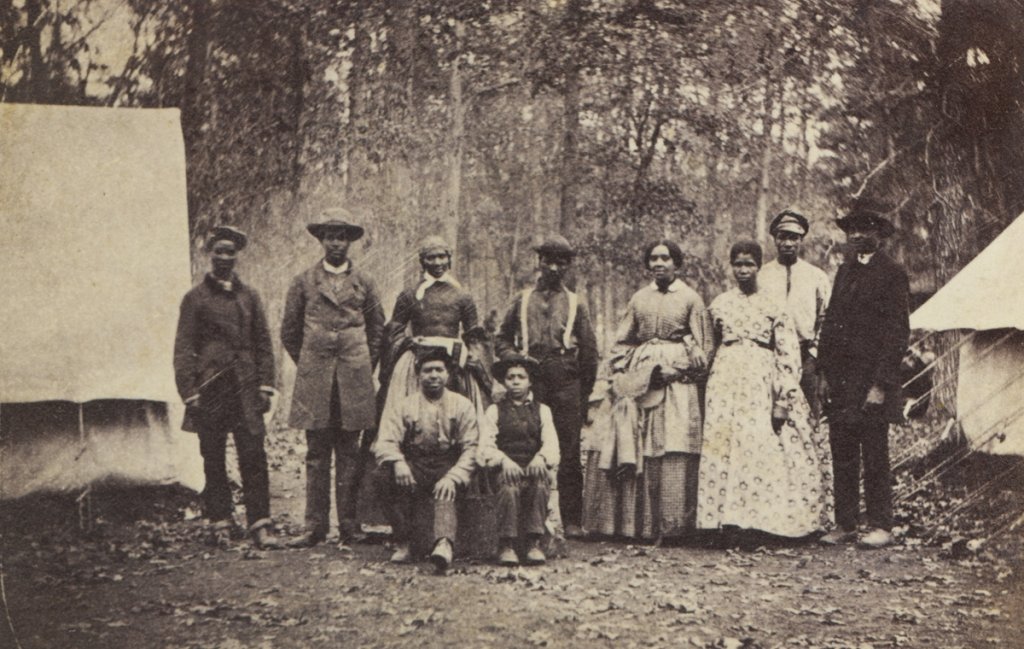Discover The Story
African Americans: The Struggle for Freedom
My feelings are always outraged when I hear them speak of “kind masters,” “Christian masters,” “the mildest form of slavery,” “well fed and clothed slaves,” as extenuations of slavery. I am satisfied they either mean to pervert the truth, or they do not know what they say. The being of slavery, its soul and body, lives and moves in the chattel principle, the property principle, the bill of sale principle…
James W.C. Pennington
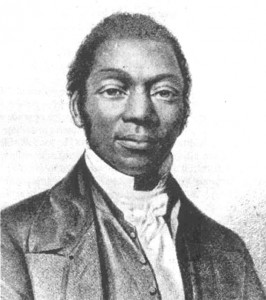 James W.C. Pennington, born a slave in Maryland, rejected the “property principle” and escaped his enslavement on the Washington County farm of his owner Frisby Tilghman in 1828. He made his way to New York where he was educated and became an articulate advocate for the abolition of slavery. Writing in 1848, Pennington reflected on Maryland’s “mildest form of slavery,” concluding, “I beg our Anglo-Saxon brethren to accustom themselves to think that we need something more than mere kindness. We ask for justice, truth, and honor as other men do.”
James W.C. Pennington, born a slave in Maryland, rejected the “property principle” and escaped his enslavement on the Washington County farm of his owner Frisby Tilghman in 1828. He made his way to New York where he was educated and became an articulate advocate for the abolition of slavery. Writing in 1848, Pennington reflected on Maryland’s “mildest form of slavery,” concluding, “I beg our Anglo-Saxon brethren to accustom themselves to think that we need something more than mere kindness. We ask for justice, truth, and honor as other men do.”
Justice, in the form of emancipation for the enslaved African Americans throughout the United States, was still more than a decade away in 1848. It would take a Civil War to create the environment necessary to push politicians to abolish slavery, even if not for “justice, truth, and honor.” The 1862 Civil War battle at Antietam Creek near Sharpsburg, which precipitated Lincoln’s Emancipation Proclamation freeing the slaves in the rebellion states, took place on Maryland ground. But ironically, the Emancipation Proclamation did not free Maryland’s slaves. They continued to live in bondage until the Maryland legislature passed a new constitution freeing the slaves in 1864. Like James Pennington and others before, many chose not to wait.
Slavery on the Border
Slavery, the dehumanizing subordination of a group of individuals by another, was sustained by a deep-rooted belief that the black African race was inherently inferior and therefore properly subjugated to the white European. Based in this belief, slavery served its purpose as an economic system, which provided a constant source of cheap labor.
Maryland’s neighbor to the north, Pennsylvania, abolished slavery in 1780, although the actual freeing of slaves occurred very gradually for years afterwards. Slavery was not fully extinct in Pennsylvania until 1847. To the south, Virginia maintained slavery until the Civil War ended the institution. In the counties of Jefferson and Loudoun, the number of those enslaved remained relatively stable between 1820 and 1860. By the latter year, the enslaved made up 27% of the total population of Jefferson County, and 25% of Loudoun County. In Maryland, by contrast, slavery declined steadily in the decades before the Civil War, and the number of free Africans Americans in the state in 1860 almost equaled the number of those enslaved.
Slavery in Maryland varied in its application as widely as the diverse geographical regions of the state. Ethnic, religious, and ultimately the political differences of the regional populations further emphasized the geographic and economic divisions. All of these variables shaped not only the characteristics of slavery as it was applied in the various Maryland regions, but also the gradual state-wide move away from the institution toward free labor. Between 1790 and 1860, the slave population in Maryland as a whole declined. At the same time, the free black population increased due to manumissions and free births (children of free women were born free), and to a small extent from fugitives from the South.
On the tobacco growing plantations of the Eastern Shore and southern Maryland, the slave labor system seemed well suited to the labor-intensive production of tobacco. In these regions, primarily occupied by wealthy English or Scotch-Irish landowners, the social and economic composition closely resembled that of their southern neighbors inVirginia. Northern and western Maryland, including Frederick, Washington, and later Carroll County, largely settled by German immigrants and their descendents migrating from Pennsylvania, developed grain-based farming economies. The more seasonal labor requirements of grain farming were less conducive to the expense of holding large numbers of slaves throughout the year. Free black and immigrant day laborers formed the core of the labor force in these regions.
In 1790, only 10% of the families living in Washington County were slave owners, accounting for approximately 1,200 enslaved African Americans, about 8% of the county’s total population. Most owned fewer than four slaves; only six families owned twenty or more slaves. Slave owners in Frederick County (including most of later Carroll County) held 3,600 men, women, and children enslaved in 1790, over 11% of the total population. Comparison with the tobacco-based farm culture found in the southern Maryland county of St. Mary’s is enlightening. St. Mary’s County listed 50% of the families living in the county as slave owners, with two families owning 100-200 or more slaves, and 73 families owning more than twenty slaves. Slaves in St. Mary’s County accounted for nearly 50% of the county population.
Given the cyclical work of the grain farms, how were slaves occupied on mid-Maryland farms? Owners of five or more adult slaves in the region tended to have larger, more diversified farms capable of occupying their slave labor force throughout the year. Frisby Tilghman’s large Washington County wheat farm of nearly a thousand acres known as Rockland Plantation included a slave blacksmith and several young slaves trained as masons, skills that would keep them busy outside of the harvest season. During harvest season, when labor needs expanded greatly for a short period of time, farmers hired day laborers, both free black and white.
John Blackford’s journal of the daily workings on his Ferry Hill Plantation west of Sharpsburg, written in the 1830s, recorded the wide variety of jobs that occupied his large number of slaves throughout the year. Blackford permanently employed two of his slaves as ferrymen on his commercial Potomac River ferry crossing. Blackford also operated a busy cordwood and shingle cutting business, which occupied several slaves as well as white day laborers year around. Sheep shearing, general maintenance, and errands were also jobs performed by Blackford’s slaves. During the July wheat harvest of 1838, he reported hiring at least three laborers, Nelson, Charles, and Nicholas Voluntine, in addition to his five slaves at work in the fields.
Though John Blackford might have been considered a “kind master,” giving his ferrymen slaves Ned and Jupe a surprising amount of independence, nonetheless, Blackford’s slaves did resist their condition. Daphney reportedly poisoned herself to induce a miscarriage of her baby – who would have been born a slave-for-life – and several of Blackford’s slaves attempted escape. James W. C. Pennington, who escaped his enslavement on the Rockland Plantation of Frisby Tilghman in 1828, later described his master’s disposition:
…his prevailing temper was kind, but he was a perpetualist. He was opposed to emancipation, thought free Negroes a great nuisance, and was, as respects discipline, a thorough slaveholder. He would not tolerate a look or a word from a slave like insubordination. He would suppress it at once, and at any risk. When he though it necessary to secure unqualified obedience, he would strike a slave with any weapon, flog him on the bare back, and sell.
The sale of slave property often divided families, many permanently, though some like Jared Franklin found a way to unite. Jared Franklin, born a slave on the Carroll County farm of J. Ross Key, the father of Francis Scott Key, described in his own narrative the loss of his family by sales. Jared had married 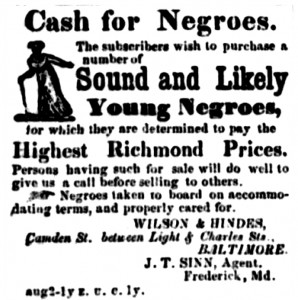 Ann, a slave belonging to Adam Good of Taneytown, Maryland. When Francis Scott Key married and moved to Georgetown, he took Jared with him. After two years of separation, Key sold Jared to Adam Good. Jared and Ann Franklin had two children, Henry and Harriet, while enslaved to Good. But when Good became insolvent about 1813, “his property was disposed of,” resulting in the breakup of the Franklin family. Jared was sold to Joseph Engle of Little Pipe Creek; Ann and Harriet were sold to Philip Wampler; and Henry was purchased by Abraham Shriner of Little Pipe Creek. Years later, Jared, Ann, and Harriet were emancipated, and Henry escaped his bonds in 1837 running to Quakertown, Pennsylvania, where the family eventually reunited.
Ann, a slave belonging to Adam Good of Taneytown, Maryland. When Francis Scott Key married and moved to Georgetown, he took Jared with him. After two years of separation, Key sold Jared to Adam Good. Jared and Ann Franklin had two children, Henry and Harriet, while enslaved to Good. But when Good became insolvent about 1813, “his property was disposed of,” resulting in the breakup of the Franklin family. Jared was sold to Joseph Engle of Little Pipe Creek; Ann and Harriet were sold to Philip Wampler; and Henry was purchased by Abraham Shriner of Little Pipe Creek. Years later, Jared, Ann, and Harriet were emancipated, and Henry escaped his bonds in 1837 running to Quakertown, Pennsylvania, where the family eventually reunited.
By 1850, Maryland’s trend away from enslaved labor was evident in the census record. Only about 6.4% of Washington County’s population was enslaved, and 6% was “free colored.” In Frederick County, of the 41,000 people living in the county, 3,900 were enslaved and 3,800 were “free colored.” And in Carroll County, occupied by just over 20,000 souls, 375 African Americans were enslaved and 374 were freedmen. Pennsylvania was a free state by 1850, but in Loudoun County, Virginia, more than 5,600 African American men, women, and children labored in the bonds of slavery while just over 1,300 were free. By 1860, the mid-Maryland counties of Carroll, Frederick, and Washington included a larger population of free African Americans than those enslaved (7,859 free to 5,461 enslaved).
Freedmen in the rural counties were largely farm laborers. A few were skilled workers, like Robert Anderson of Washington County and Thomas Duckett of Frederick City who were occupied as masons in 1860. Jacob Seibert, a freedman living in Harpers Ferry, Virginia in 1860 worked as a cook, while free blacks living in Gettysburg, Pennsylvania were occupied as servants, day laborers, and skilled craftsmen including Albert Palm a brickmaker and Samuel Weldon a shoemaker.
In October 1860, the editor of the Hagerstown newspaper Herald & Torch noted with remarkable insight the impending devastation the Civil War would bring:
Washington county is a border county, and the people of no State and no county have suffered more from the accursed agitation of slavery than they, and none would share larger in the horrors of a dissolution of the Government.
Literally sandwiched between the southern slave states and the northern free states,Maryland, and mid-Maryland in particular, was politically and economically divided, a microcosm of the divided Union. In September 1862, Sharpsburg, located on the Antietam Creek in Washington County, stood at the center of a battle that altered the war and the slavery debate. The outcome of the Battle of Antietam precipitated President Abraham Lincoln’s issuance of the Emancipation Proclamation, freeing the slaves in the rebelling states. Ironically, although the battle took place on Maryland ground, those enslaved in Maryland, a Union state, would continue to live in bondage for two more years. But the politics and circumstances of the Civil War were bringing closer the long hoped for freedom.
Escape, Enlist, Entrench
By 1860, following John Brown’s failed attempt at insurrection in Harpers Ferry in 1859, many of the enslaved people below the Mason-Dixon Line believed their fate was in their own hands. Their answers lay not in the laws and justice of the white majority, but in a number of self-propelled routes to freedom. The Underground Railroad was perhaps the most invaluable aid to individuals on the road to freedom, but there were other paths as well during the period of the Civil War: self-purchase, enlistment in the Union army (1863), escape to a Union encampment, even suicide.
Escape
The Underground Railroad (UGRR) had been in operation throughout the mid-Atlantic region since as early as the 1780s. George Washington related in a letter to Robert Morris that Quakers in the Philadelphia area had aided in the escape of a slave from Alexandria, Virginia. By the 1850s the UGRR had developed into a complex network of “stations” leading to destinations in Pennsylvania, Ohio, New England, and Canada. There were agents in Maryland, both black and white – Harriet Tubman perhaps the most well-known of the Maryland UGRR agents – but there are others whose names will never be known. In Washington County, two brick makers from Hagerstown, George Stimitz and Frederick Shriver, were accused of being agents of the UGRR and of inducing a Loudoun County, Virginia slave to escape in 1858.
For fugitives running from Virginia’s lower Shenandoah Valley or from Maryland locations, the flight to Pennsylvania was relatively short. James Pennington’s journey to freedom in 1828 was fairly typical – he walked established roads by night following the North Star – but also fraught with peril. Pennington’s journey to freedom was much longer than necessary because the nights were cloudy and he was often unable to follow the North Star. Instead of going north, Pennington mistakenly walked 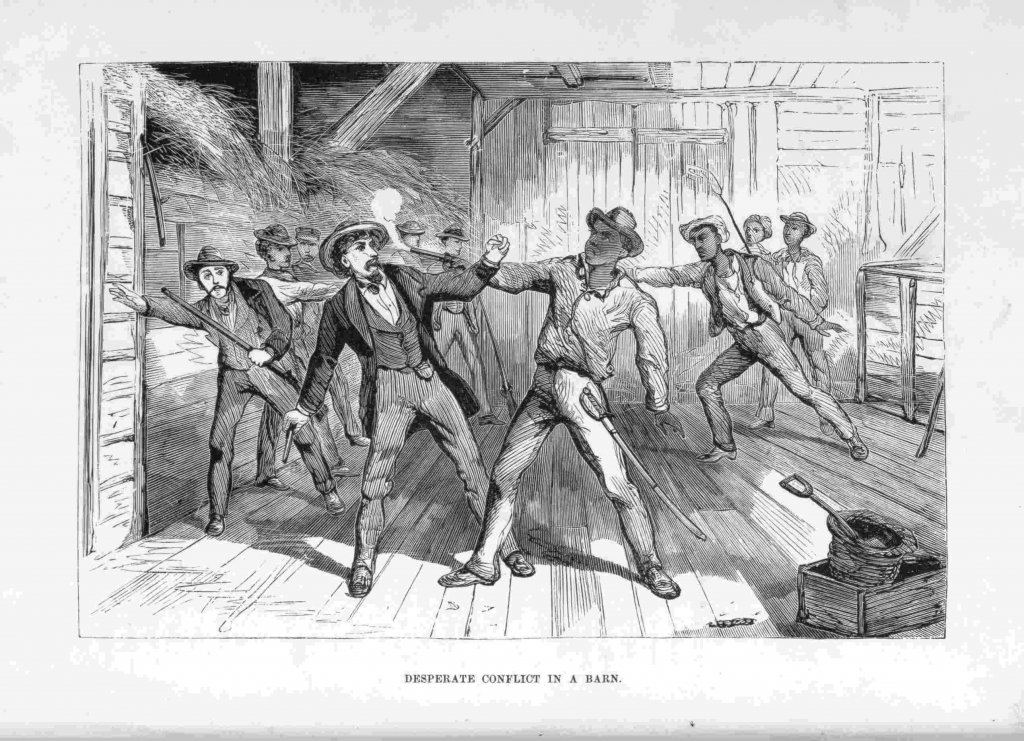 east, toward Baltimore. Like other fugitives, Pennington had to be wary of slave hunters and was even caught once by locals in Baltimore County. With luck on his side, Pennington found his way to Pennsylvania and stumbled onto the farm of an UGRR agent. In 1853, Virginia slave Wesley Harris (alias Robert Jackson) had a similar experience. Escaping from Harpers Ferry with several companions, Harris was captured in a barn near “Terrytown, Md.” [Taneytown] in Carroll County. Although severely injured, Harris escaped with the help of sympathetic black servants in the tavern where he was recuperating. He made his way to Gettysburg, Pennsylvania and freedom, but his comrades were taken to jail in Westminster, Maryland.
east, toward Baltimore. Like other fugitives, Pennington had to be wary of slave hunters and was even caught once by locals in Baltimore County. With luck on his side, Pennington found his way to Pennsylvania and stumbled onto the farm of an UGRR agent. In 1853, Virginia slave Wesley Harris (alias Robert Jackson) had a similar experience. Escaping from Harpers Ferry with several companions, Harris was captured in a barn near “Terrytown, Md.” [Taneytown] in Carroll County. Although severely injured, Harris escaped with the help of sympathetic black servants in the tavern where he was recuperating. He made his way to Gettysburg, Pennsylvania and freedom, but his comrades were taken to jail in Westminster, Maryland.
Beginning in 1841 Gettysburg was host of the Slave’s Refuge Society, established by five members of the St. Paul’s African Methodist Episcopal (AME) Church. The founders stated their intention declaring: “We feel it our indispensable duty to assist such of our brethren as shall come among us for the purpose of liberating themselves, and to raise all the means in our power to effect our object, which is to give liberty to our brethren groaning under the tyrannical yoke of oppression.” In 1858, Basil Biggs, a free African American from Carroll County, Maryland, moved to Gettysburg and opened his home to fugitives, leading them to Quaker Valley under cover of night where they continued their journey north.
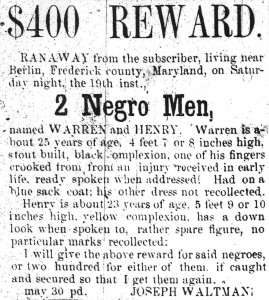 During the decade leading up to the Civil War, new state and federal laws made the avenues to freedom much harder to navigate. With the passage of the federal Fugitive Slave Act in 1850, many escaping slaves from Maryland and Virginia were not as lucky as Pennington and Harris. Moses Horner, who escaped from his enslavement in Jefferson County, Virginia (now West Virginia), was working near Harrisburg, Pennsylvania in 1860 when he was arrested as a fugitive slave. Horner was tried in federal court, found guilty, and “remanded to the custody of his owner,” Charles T. Butler. Others never made it as far as Pennsylvania, caught by locals or slave hunters and held in various Maryland county jails. In June 1856, John Bacon, slave of Wilkens Glenn of Baltimore, escaped his employer near Sykesville in Howard County but was caught and jailed in Carroll County. Sheriff Joseph Shaeffer described young Bacon as having “an honest and interesting appearance.” In 1859, Carroll County Sheriff William Wilson advertised the capture of runaway William Adams. The stream of runaways became a stampede in 1860, because of a new state law prohibiting manumissions according to one Frederick County newspaper:
During the decade leading up to the Civil War, new state and federal laws made the avenues to freedom much harder to navigate. With the passage of the federal Fugitive Slave Act in 1850, many escaping slaves from Maryland and Virginia were not as lucky as Pennington and Harris. Moses Horner, who escaped from his enslavement in Jefferson County, Virginia (now West Virginia), was working near Harrisburg, Pennsylvania in 1860 when he was arrested as a fugitive slave. Horner was tried in federal court, found guilty, and “remanded to the custody of his owner,” Charles T. Butler. Others never made it as far as Pennsylvania, caught by locals or slave hunters and held in various Maryland county jails. In June 1856, John Bacon, slave of Wilkens Glenn of Baltimore, escaped his employer near Sykesville in Howard County but was caught and jailed in Carroll County. Sheriff Joseph Shaeffer described young Bacon as having “an honest and interesting appearance.” In 1859, Carroll County Sheriff William Wilson advertised the capture of runaway William Adams. The stream of runaways became a stampede in 1860, because of a new state law prohibiting manumissions according to one Frederick County newspaper:
STAMPEDE OF NEGROES
On Monday night (Whitmonday) some eight or ten slaves, belonging to persons in this city and vicinity, absconded in a body…. The plan of the fugitives was evidently preconcerted, and advantage was taken of the holiday to make good their escape. It has been suggested that the approach of the first of June, on which day the law forbidding manumissions will go into effect, was the cause of their departure…
Manumission had become a common path to freedom, particularly in mid-Maryland. For some owners perhaps it was a way to clear the conscience, for others a way to relieve oneself of unprofitable labor. Many saw the looming demise of the institution of slavery by 1860. One local newspaper observed that year:
There were fifty slaves manumitted in Washington County previous to the first of June, the period when the new law on that subject went into operation. The manumissions, however, do not in most cases take effect immediately, some of them having been extended to 1870 and ’75.
With the advent of the Civil War came new avenues to freedom. Peter Booker and Charles Turner tried a new twist on the old escape plan, wearing army uniforms and claiming to be soldiers in 1862. Carroll County Sheriff Jeremiah Babylon caught the two fugitive slaves and held them in the Westminster jail, clearly not convinced by their story. A Hagerstown newspaper reported in March 1862, “as many as two thousand fugitive slaves from the Valley of Virginia have crossed the Potomac within the last ten days,” the result of “the rebellion inaugurated by the Cotton states.”
During the Civil War, perhaps the most common escape plan for slaves was to take shelter among the Union troops located in Virginia, Maryland, and the District of Columbia. Maryland, as a border slave state held within the Union, was occupied by federal troops throughout the Civil War. The Baltimore & Ohio Railroad and Chesapeake & Ohio Canal were important supply routes for the Union army and their close proximity to Virginia along Maryland’s Potomac River bank made protection of the two
transportation routes a priority. The encampments of federal troops in Maryland became a common destination for runaway slaves, known as contraband. One Hagerstown newspaper called the loss of slaves to the refuge of the Union encampments “emancipation without compensation.” One such fugitive from the slave market town of Licksville in Frederick County, Maryland was John T. Weedon, who escaped to a Union army camp, where he worked through the remainder of the war as a mule tender.
When Congress abolished slavery in the District of Columbia in April 1862, it precipitated a flood of fugitive slaves into the city. From Sharpsburg in Washington County, Savilla Miller wrote to her sister in Iowa in 1862:
…Sunday night…old black Sam walked off….[They go] to Martinsburg…[to] get on the cars [train] and go to Washington City, then they are free.
A Frederick County newspaper reported in March 1862 that the, “train from Harpers Ferry last Friday evening brought to Frederick 64 contraband slaves. They are to be sent to Washington to be employed in the Commissary department.”
While many enslaved African Americans in the region were attempting to obtain freedom, those who were already free had to avoid enslavement. When Confederate armies occasionally crossed the Potomac River, many free African Americans fled the area to avoid being captured and enslaved by the Southerners. In 1863, during the Confederate invasion of Pennsylvania, at least several hundred African Americans were kidnapped by Confederate soldiers and taken south to be sold as slaves.
Enlist
On July 17, 1862, Congress passed the Second Confiscation and Militia Act, authorizing African Americans to serve in the Union army. African Americans could now serve in the Army in any capacity that President Abraham Lincoln deemed “best for the public welfare,” but he was not yet ready to allow their use in combat.
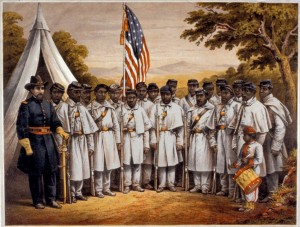 The Emancipation Proclamation in January 1863 changed that. In late January 1863, Massachusetts began recruiting free African American men, forming the 54th Massachusetts Regiment. So many men volunteered that another regiment, the 55th, was also organized. A recruiter for the 54th must have targeted south-central Pennsylvania because forty-three men from Franklin County alone joined the 54th, including four brothers from the Christy family of Mercersburg and three of their brothers-in-law.
The Emancipation Proclamation in January 1863 changed that. In late January 1863, Massachusetts began recruiting free African American men, forming the 54th Massachusetts Regiment. So many men volunteered that another regiment, the 55th, was also organized. A recruiter for the 54th must have targeted south-central Pennsylvania because forty-three men from Franklin County alone joined the 54th, including four brothers from the Christy family of Mercersburg and three of their brothers-in-law.
The recruitment of African American soldiers in mid-Maryland was hugely successful through the summer 1863 with as many as 200 just from the border area of Frederick and Carroll counties, 70-80 from the Clear Spring district in Washington County, while 40 men – “including a negro brass band” called the Moxley Band – reported from Hagerstown. Some Maryland slave-owners claimed, however, that enlistment officers were illegally recruiting enslaved men. On March 21, 1863, Col. Robert Creager was arrested for “enticing slaves to escape from their owners,” after visiting an “African church” in Frederick where he recruited “50 or 60 negroes, among them several slaves.”
In general however, recruitment elsewhere proved slow. In October 1863 the War Department issued General Order 329 providing “for enlistment of free blacks, slaves of disloyal owners, and slaves of consenting loyal owners in the border states.”
Section 6 of the order stated that if any citizen should offer his or her slave for enlistment into the military service, that person would, “if such slave be accepted, receive from the recruiting officer a certificate thereof, and become entitled to compensation for the service or labor of said slave, not exceeding the sum of three hundred dollars, upon filing a valid deed of manumission and of release, and making satisfactory proof of title.”
Enslaved men enlisted in the Union army in this way would be free men at the end of their service. Owners loyal to the Union were entitled to compensation for the enlistment of their slaves, and some owners in Maryland viewed this as their last opportunity to receive payment for the loss of their property. Twenty such owners in WashingtonCountyclaimed compensation for the enlistment of 27 slaves. A list of drafted men from two districts in Frederick County included six slaves. In an ironic twist at the final battle for Richmond in April 1865, Jesse Downey and Ignatius Dorsey, two landowners from Frederick County serving in the Confederate 1st Maryland Regiment, faced their former slaves John Williams and Lewis Wineberry, soldiers in the United States Colored Troops (USCT).
Others were not so eager to send their slaves to war. John Otto of Sharpsburg paid the $300 bounty to release his slave Hilary Watson from the draft. Henry Piper, also of Sharpsburg, was similarly 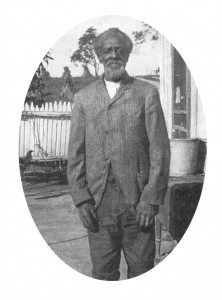 determined to protect his slave Jeremiah Summers. In April 1864, a company of USCT arrived in Sharpsburg and set up a recruitment office in the local Methodist Church. Led by Captains Holsinger and Fletcher, they began “enlisting” local African Americans:
determined to protect his slave Jeremiah Summers. In April 1864, a company of USCT arrived in Sharpsburg and set up a recruitment office in the local Methodist Church. Led by Captains Holsinger and Fletcher, they began “enlisting” local African Americans:
…that day, divers colored men, free and slave, were seized and taken to the Quarters aforesaid, among them, “Jeremiah Summers,” colored boy owned and possessed by Henry Piper of said Town. Said boy being about 16 years and 9 months old, he Summers by reason of his minority, never having been enrolled, and hence no way liable to Military duty.
Although Piper, a staunch Union loyalist, protested the seizure of his young slave, Summers and the others were moved from Sharpsburg the same day. Henry Piper and a group of Sharpsburg citizens petitioned General Lew Wallace, then commanding the Middle Department, U.S. Army, in Baltimore and young Summers was returned to the Piper farm.
Simply being allowed into the army was only the first hurdle experienced by African Americans who were willing to fight and die for their country. Racism infected all sectors of American society in the nineteenth century, and many white Union officers and soldiers disparaged the abilities of the new recruits. African American soldiers were subjected to unequal pay, menial duties, dilapidated barracks, derision by many fellow soldiers, and a reluctance to allow them in actual combat. Jacob Christy, from Mercersburg, Pennsylvania and a member of the 54th Massachusetts Regiment, expressed frustration in a letter to his sister about African American soldiers not receiving pay, and spoke of his determination to fight for the rights of African Americans:
We have been fighting as brave as ever [thay?] was any soldiers fought[.] I know if every regiment that are out and have been out would have dun as well as we have the war would be over[.] I du really think that its God will that this [war] Shall not end till the Colord people get thier rights[.] [I]t goes verry hard for the White people to think of it But by gods will and powr thay will have thier rights[.] [U]s that are liveing [now] may not live to see it[.] I shall die a trying for our rights so that other that are born hereaffter may live and enjoy a happy life[.]
The Union Army’s seemingly insatiable need for men proved greater than racism, however, and the new African American units were finally thrust into battle, albeit in segregated units called the United States Colored Troops (USCT). For the final two years of the war, these men proved their valor. USCT units fought in all theaters of the war, and according to one historian, participated in almost 450 military engagements, 39 of which were major battles. Twenty-three African American soldiers were awarded the Medal of Honor.
In Maryland, even though the War Department’s orders of October 1863 had established two recruiting stations in mid-Maryland – at Hagerstown and Monocacy Junction – for African Americans who wanted to join the Union army, the local Provost Marshall’s office was slow in figuring out how to proceed with the enlistment of black soldiers. In January 1864, provost marshall James Smith wrote to his superior in Baltimore, N.L. Jeffries, the Provost Marshall of Maryland, asking, “Shall I use my efforts to enlist negroes? Shall I swear and muster them in? Numbers of them might be got in this District.” Smith had been asked about black recruits several months before by his Deputy Provost Marshall in Washington County, F. Dorsy Herbert, who had written in a letter to Smith:
If a company of colored men should be raised will they be accepted and mustered into service? A gentleman by the name of Prather who resides in Clearspring informs me that he can enlist a company in that vicinity before the draft comes off – provided they will be accepted, and that he will take command of the company.
Smith again asked his commanding officer for instructions in February 1864, as more and more African Americans desired to enlist.
I am interrogated every day in relation to the enlistment of negroes, by whom they are to be recruited? What bounty is to be given? And what pay promised them? Those people are going off every day to Pa.and yet all is uncertainty and inaction here. My understanding of the matter is that I am not expected to recruit colored men at all, and I so inform persons who apply to me on that subject. It seems to me that the two classes, white and black, ought to be enlisted separately and by different officers. Be that as it may, no person here seems authorized to enlist them, and they go away and are lost to the State.
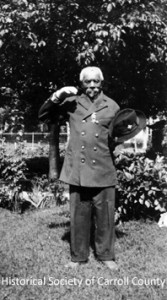 Smith’s fears of losing black recruits were further confirmed the day after writing Jeffries, in a letter he received from B.F. Kendall, the new Deputy Provost Marshall for Washington County. “It has been suggested to me this evening,” wrote Kendall, “that some effort ought to be made to secure by enlistment as many of our free Negroes as possible for the army – it is believed secret agents are here offering them inducements to enter regiments from Northern States.” Kendalladded, “We are all very anxious to see recruiting commenced.” Smith himself had written to Jeffries a month earlier telling him that the irrepressible Colonel Creager, now out of jail, was in the area recruiting African American soldiers for northern states. Smith wrote that he had directed the arrest of anyone enlisting men at Hagerstown for northern states.
Smith’s fears of losing black recruits were further confirmed the day after writing Jeffries, in a letter he received from B.F. Kendall, the new Deputy Provost Marshall for Washington County. “It has been suggested to me this evening,” wrote Kendall, “that some effort ought to be made to secure by enlistment as many of our free Negroes as possible for the army – it is believed secret agents are here offering them inducements to enter regiments from Northern States.” Kendalladded, “We are all very anxious to see recruiting commenced.” Smith himself had written to Jeffries a month earlier telling him that the irrepressible Colonel Creager, now out of jail, was in the area recruiting African American soldiers for northern states. Smith wrote that he had directed the arrest of anyone enlisting men at Hagerstown for northern states.
Perhaps the most famous African American soldier from the region was Decatur Dorsey. Dorsey was born c.1836 near New London in Frederick County. He had been enslaved as a young man, although it is unclear whether he was a slave at the time of his enlistment. Dorsey enrolled in Company B of the 39th Regiment of the USCT in March 1864 in Baltimore. In May he was promoted to corporal and then by July, to sergeant. The 39th Regiment participated in many of the battles in Virginia in 1864, including the Wilderness Campaign and General U.S. Grant’s march to the James River and on to the siege of Petersburg.
From the summer of 1864 until the spring of 1865, Union forces kept the Confederate Army of Northern Virginia bottled up around Petersburg, Virginia. In an early attempt to break through the Confederate strong defensive lines, Union Army engineers in July 1864 dug a tunnel from the Union lines to beneath a section of the Confederate fortifications, and packed explosives in the tunnel. On July 30, the engineers exploded the charges, which produced many Confederate casualties and a huge crater in the Confederate lines. Union forces, led by USCT units, charged the Confederates, taking advantage of the panic and confusion caused by the explosion. But poor leadership and a quick recovery by Confederate reinforcements spelled disaster for the Federal units, who were mowed down as they converged in and around the crater site. Units of the USCT, including Dorsey’s regiment, were the first to be sent into the crater, and these units suffered heavy casualties. Many of the African American soldiers who participated in the battle were praised for their bravery, however, including Sergeant Decatur Dorsey. Dorsey was the color bearer for his regiment that day, and was later awarded the Congressional Medal of Honor for his actions at Petersburg. The official citation reads: “Planted his colors on the Confederate works in advance of his regiment, and when the regiment was driven back to the Union works he carried the colors there and bravely rallied the men.”
For the state as a whole, by the war’s end, over 8,700 African Americans from Maryland had enlisted for the Union. Almost 900 of these soldiers came from Carroll, Frederick, and Washington counties, and at least 156 of these had been enslaved before enlistment.
Entrench
While many free and enslaved African Americans chose to leave the area and move further north, especially during the three Confederate invasions of the region, others took advantage of the new economic opportunities presented by the war. Some became teamsters for the U.S. Army or sold produce and other items to the ever-present encampments of soldiers. One soldier in Williamsport, in Washington County, remarked in a letter that his fellow soldiers all bought milk from a local African American woman and that she also washed clothes for the men. Nathan Williams, whose farm included the ruins of Fort Frederick in far western Washington County, sold produce to soldiers on both sides of the Potomac River. Williams reportedly shared information he garnered about Confederate movements with his Union customers.
Others who did not leave the region endured the war by going about their business, and keeping a low profile. Benjamin Tucker Tanner served as the minister of Quinn’s Chapel in Frederick during the latter 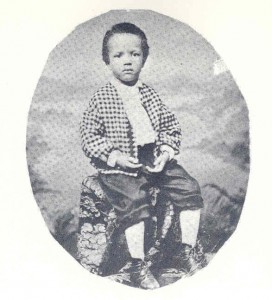 half of the war, and his son, Henry Ossawa Tanner, later wrote about his memories of the family’s wartime experiences. “From our attic window the rebel camp and soldiers could be seen. Once my father for some cause was at the [church] and by his clothes was recognized as a minister. ‘Hello!” [said a soldier to his father] “…what are you doing with those duds on, take this,’ and he was kicked out of the [church]. I believe my father said he was drunk.” Henry also remembered that his father took the precaution of nailing boards over the windows in the house to make it look abandoned, and although rebel soldiers passed by their house all day long, only one stopped to bang on the door, and he was told by an officer to move on.
half of the war, and his son, Henry Ossawa Tanner, later wrote about his memories of the family’s wartime experiences. “From our attic window the rebel camp and soldiers could be seen. Once my father for some cause was at the [church] and by his clothes was recognized as a minister. ‘Hello!” [said a soldier to his father] “…what are you doing with those duds on, take this,’ and he was kicked out of the [church]. I believe my father said he was drunk.” Henry also remembered that his father took the precaution of nailing boards over the windows in the house to make it look abandoned, and although rebel soldiers passed by their house all day long, only one stopped to bang on the door, and he was told by an officer to move on.
The war brought additional burdens to African American families. Even in the best of times, African Americans were usually employed in the lowest-paying jobs. When African American men left the region to avoid capture or to fight for the Union Army, women had to work that much harder. David Demus, from Mercersburg, fought with the 54th Massachusetts, and letters between Demus and his wife Mary Jane reveal the hardships of surviving the war. In 1863, in reply to a letter from Mary Jane in which she told him she was working in a field husking corn, Demus was upset that she was doing that kind of work and told her she should stop. In another letter, Mary Jane tells her husband that she will have to hire herself out because everything is so expensive and she has to earn money. In March of 1864, Demus wrote to Mary Jane, “[I] am sorry to think how you hafe to get a long[.] [I] never thot that you [would] hafte to Wark so hard to get a long[.]” Part of the problem was that Demus’ pay as a soldier was irregular, and he often complained of not getting paid at all. In April 1864, Demus wrote to his wife that he would get paid soon, and he wanted her to stop working outside the home because he knew that “you Cant stande it mutch longer….” Life was tenuous in the best of times for African Americans, and war made life even more difficult.
A New Beginning
President Lincoln’s Emancipation Proclamation of January 1863 freed those enslaved in Virginia and the other the rebellious states of the South. In reality those slaves were not truly free until the end of the war in April 1865 and then later that year by the passage of the 13th Amendment to the U.S. Constitution which officially abolished slavery throughout the United States.
The enslaved people living in the border states of Maryland, Kentucky, Delaware, and Missouri, all slave states still within the Union during the war, were not included in the Emancipation Proclamation. In 1864, the strongly pro-Union Unconditional Unionists of Maryland, in control of Maryland’s political machinery at the time, proposed a new state constitution that included a measure to abolish slavery in the state. In a close vote by Maryland’s citizens, the new constitution was approved, and on November 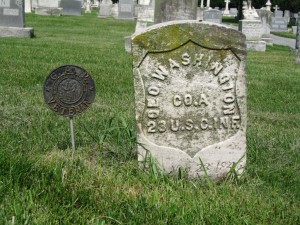 1, 1864, Maryland slaves were emancipated, ending a long struggle for freedom and beginning the long road to equality. In one of those odd historical twists of fate, Roger Brooke Taney, the former Frederick resident and the Chief Justice of the Supreme Court who authored the infamous Dred Scott decision that ruled that African Americans could never become citizens of the United States, passed away on the day Marylanders voted to abolish slavery. Taney is buried in Frederick, only yards away from the grave of George Washington, a veteran of the United States Colored Infantry, who fought for freedom for all African Americans and for their right to become full citizens of the United States.
1, 1864, Maryland slaves were emancipated, ending a long struggle for freedom and beginning the long road to equality. In one of those odd historical twists of fate, Roger Brooke Taney, the former Frederick resident and the Chief Justice of the Supreme Court who authored the infamous Dred Scott decision that ruled that African Americans could never become citizens of the United States, passed away on the day Marylanders voted to abolish slavery. Taney is buried in Frederick, only yards away from the grave of George Washington, a veteran of the United States Colored Infantry, who fought for freedom for all African Americans and for their right to become full citizens of the United States.
*For African American experiences after the war, please see the essay in the “Reconstructing the Region” section.
This essay was contributed by Edith B. Wallace, M.A., Historical Research and Historic Context Development Services, Paula S. Reed and Associates, Inc., Hagerstown, Maryland.
